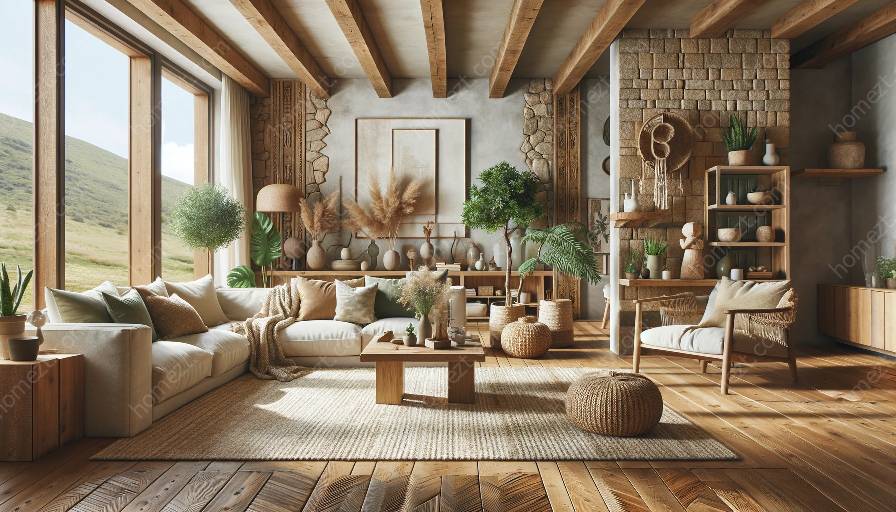Modern minimalist interior design often relies on natural materials to create a warm, inviting, and environmentally friendly living space. The use of natural materials adds a sense of harmony and tranquility to the home, while embracing sustainable and eco-friendly design principles. In this comprehensive guide, we will explore the significance of natural materials in modern minimalist interior design and provide valuable insights on how to decorate with natural materials to create a stylish, contemporary, and nature-inspired living environment.
The Significance of Natural Materials in Modern Minimalist Interior Design
Natural materials play a crucial role in modern minimalist interior design, as they bring the beauty and serenity of the outdoors into the home. Embracing natural materials such as wood, stone, bamboo, cork, and jute allows for a seamless blend of functionality and aesthetics. These materials contribute to a sense of warmth, texture, and authenticity that characterizes minimalist design. Moreover, natural materials exude a timeless elegance and durability, making them an ideal choice for creating a sustainable and long-lasting living space.
Benefits of Natural Materials
The use of natural materials in interior design offers numerous benefits in terms of aesthetics, functionality, and sustainability. Some of the key advantages include:
- Eco-Friendly: Natural materials are renewable and biodegradable, making them an environmentally conscious choice for interior design. By opting for natural materials, you can reduce the environmental impact of your home while promoting sustainability.
- Timeless Appeal: Natural materials age gracefully and develop a unique patina over time, adding character and charm to the living space. Their timeless appeal ensures that they will remain stylish and relevant for years to come.
- Health and Wellbeing: Natural materials contribute to a healthy indoor environment by reducing the presence of toxins and VOCs (volatile organic compounds). They also have innate properties that can regulate humidity and air quality, promoting overall wellbeing.
- Versatility: Natural materials offer a versatile design palette, allowing for endless possibilities in creating a cohesive and harmonious interior. Whether used as flooring, wall cladding, furniture, or decorative elements, natural materials can adapt to various design styles and preferences.
Decorating with Natural Materials
Integrating natural materials into your interior design scheme can be a transformative and enriching experience. By leveraging the unique characteristics of natural materials, you can infuse your home with a sense of tranquility, simplicity, and sophistication. Here are some effective ways to decorate with natural materials:
Wood
Wood is one of the most prevalent natural materials in minimalist interior design, renowned for its warmth, versatility, and timeless appeal. Incorporate wooden elements such as hardwood flooring, exposed beams, or handcrafted furniture to introduce a natural, organic ambiance into your home. Consider using reclaimed or sustainably sourced wood for an eco-friendly touch.
Stone
Stone provides a tactile and visually striking element in minimalist interiors. Whether it’s marble countertops, slate flooring, or granite accents, the use of natural stone adds a sense of luxury and sophistication. Its durability and unique patterns make it an ideal material for creating statement pieces while adding a touch of nature to the space.
Textiles
Natural textiles such as cotton, linen, and wool are excellent choices for soft furnishings and decor accessories. Opt for natural fiber rugs, cushions, and curtains to introduce texture and comfort while embracing a sustainable approach to interior design.
Bamboo and Cork
Bamboo and cork are sustainable alternatives that offer exceptional durability and visual appeal. From bamboo flooring to cork wall tiles, these materials provide a contemporary and eco-conscious solution for modern interiors. Their natural textures and earthy tones are perfect for creating a serene and inviting atmosphere.
Jute and Sisal
Jute and sisal are natural fibers known for their robustness and earthy aesthetic. Incorporate them into your interior design through area rugs, baskets, or decorative accents to infuse the space with a rustic yet modern sensibility.
Embracing Sustainable Design Principles
When decorating with natural materials, it’s essential to prioritize sustainable practices and ethical sourcing. Look for certifications such as Forest Stewardship Council (FSC) for wood products, and Global Organic Textile Standard (GOTS) for textiles to ensure that your materials are ethically produced and environmentally responsible. Additionally, consider upcycling, repurposing, and supporting local artisans to further promote sustainable design choices.
Conclusion
The use of natural materials in modern minimalist interior design offers an opportunity to reconnect with nature and create a peaceful sanctuary within the home. By incorporating natural materials such as wood, stone, bamboo, cork, and jute, you can elevate the aesthetic appeal of your living space while fostering a sustainable and eco-friendly environment. Whether you are drawn to the timeless elegance of wood, the luxurious allure of stone, or the eco-conscious qualities of bamboo and cork, decorating with natural materials provides endless possibilities for creating a stylish, harmonious, and nature-inspired home.






































